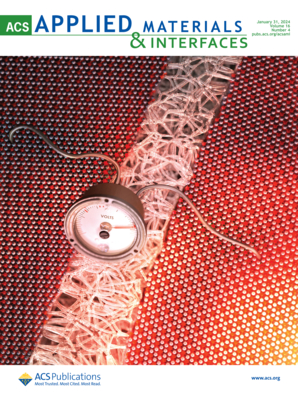In Situ Anchoring of Co Single Atoms within Keto-Enamine COFs via the Coordination of an Interlayer N Atom with Co for the Enhanced Photocatalytic CO2 Reduction Efficiency
IF 8.3
2区 材料科学
Q1 MATERIALS SCIENCE, MULTIDISCIPLINARY
引用次数: 0
Abstract
Single-atom catalysts (SACs) are prone to agglomeration or migration during catalytic processes, making the development of highly dispersible SACs greatly essential for the performance of photocatalytic CO2 reduction. Herein, cobalt-containing keto-enamine covalent organic frameworks (COFs) (Co/TpPa-1) are successfully in situ synthesized by utilizing the interlayer nitrogen atom coordinated with metallic cobalt, which is used to effectively prevent the agglomeration of monometallic atoms to ensure the homogeneous dispersion of SACs in the resulting metalized COFs. In the photocatalytic CO2 reduction, the Co/TpPa-1 composite exhibits significantly enhanced performance compared to the TpPa-1 COFs. The CO yield of 0.05 mM Co/TpPa-1 composite is approximately 414.5 μmol g–1 h–1, representing a two-order-of-magnitude improvement over the TpPa-1 COF catalyst (approximately 4.15 μmol g–1 h–1). Moreover, the 0.05 mM Co/TpPa-1 composite shows 99.45% selectivity for CO and good stability, maintaining a over 97% CO2 reduction rate after four cycles. The reason lies in the fact that the interaction between monatomic Co and TpPa-1 COFs enhances visible light absorption and extends the lifetime of the photogenerated carriers by promoting electron transfer through the loaded monatomic Co. This work provides a new idea for the catalyst synthesis with high performance and high selectivity.

通过层间N原子与Co的配位在酮-烯胺COFs中原位锚定Co单原子以提高光催化CO2还原效率
单原子催化剂(SAC)在催化过程中容易发生团聚或迁移,因此开发高分散性 SAC 对光催化还原二氧化碳的性能至关重要。本文利用金属钴配位的层间氮原子,成功地原位合成了含钴酮烯胺共价有机框架(COFs)(Co/TpPa-1),有效地防止了单金属原子的团聚,确保了 SACs 在金属化 COFs 中的均匀分散。与 TpPa-1 COF 相比,Co/TpPa-1 复合材料在光催化还原 CO2 的过程中表现出显著的性能提升。0.05 mM Co/TpPa-1 复合材料的 CO 产率约为 414.5 μmol g-1 h-1,比 TpPa-1 COF 催化剂(约 4.15 μmol g-1 h-1)提高了两个数量级。此外,0.05 mM Co/TpPa-1 复合催化剂对 CO 的选择性高达 99.45%,而且稳定性良好,在四个循环后仍能保持超过 97% 的 CO2 还原率。其原因在于单原子 Co 和 TpPa-1 COF 之间的相互作用通过促进电子通过负载的单原子 Co 转移,增强了可见光吸收并延长了光生载流子的寿命。这项工作为高性能、高选择性催化剂的合成提供了新思路。
本文章由计算机程序翻译,如有差异,请以英文原文为准。
求助全文
约1分钟内获得全文
求助全文
来源期刊

ACS Applied Materials & Interfaces
工程技术-材料科学:综合
CiteScore
16.00
自引率
6.30%
发文量
4978
审稿时长
1.8 months
期刊介绍:
ACS Applied Materials & Interfaces is a leading interdisciplinary journal that brings together chemists, engineers, physicists, and biologists to explore the development and utilization of newly-discovered materials and interfacial processes for specific applications. Our journal has experienced remarkable growth since its establishment in 2009, both in terms of the number of articles published and the impact of the research showcased. We are proud to foster a truly global community, with the majority of published articles originating from outside the United States, reflecting the rapid growth of applied research worldwide.
 求助内容:
求助内容: 应助结果提醒方式:
应助结果提醒方式:


